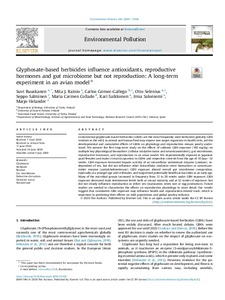Glyphosate-based herbicides influence antioxidants, reproductive hormones and gut microbiome but not reproduction: A long-term experiment in an avian model
Maria Carmen Collado; Marjo Helander; Kari Saikkonen; Suvi Ruuskanen; Miia J.Rainio; Seppo Salminen; Irma Saloniemi; Otto Selenius; Carlos Gómez-Gallego
Glyphosate-based herbicides influence antioxidants, reproductive hormones and gut microbiome but not reproduction: A long-term experiment in an avian model
Maria Carmen Collado
Marjo Helander
Kari Saikkonen
Suvi Ruuskanen
Miia J.Rainio
Seppo Salminen
Irma Saloniemi
Otto Selenius
Carlos Gómez-Gallego
ELSEVIER SCI LTD
Julkaisun pysyvä osoite on:
https://urn.fi/URN:NBN:fi-fe2021042826635
https://urn.fi/URN:NBN:fi-fe2021042826635
Tiivistelmä
Controversial glyphosate-based herbicides (GBHs) are the most frequently used herbicides globally. GBH residues in the wild, in animal and human food may expose non-target organisms to health risks, yet the developmental and cumulative effects of GBHs on physiology and reproduction remain poorly understood. We present the first long-term study on the effects of subtoxic GBH exposure (160 mg/kg) on multiple key physiological biomarkers (cellular oxidative status and neurotransmitters), gut microbiome, reproductive hormones, and reproduction in an avian model. We experimentally exposed in Japanese quail females and males (Cotumix japonica) to GBHs and respective controls from the age of 10 days -52 weeks. GBH exposure decreased hepatic activity of an intracellular antioxidant enzyme (catalase), independent of sex, but did not influence other intracellular oxidative stress biomarkers or neurotransmitter enzyme (acetylcholinesterase). GBH exposure altered overall gut microbiome composition, especially at a younger age and in females, and suppressed potentially beneficial microbes at an early age. Many of the microbial groups increased in frequency from 12 to 28 weeks under GBH exposure. GBH exposure decreased male testosterone levels both at sexual maturity and at 52 weeks of exposure, but did not clearly influence reproduction in either sex (maturation, testis size or egg production). Future studies are needed to characterize the effects on reproductive physiology in more detail. Our results suggest that cumulative GBH exposure may influence health and reproduction-related traits, which is important in predicting their effects on wild populations and global poultry industry. (C) 2020 The Authors. Published by Elsevier Ltd.
Kokoelmat
- Rinnakkaistallenteet [19207]
